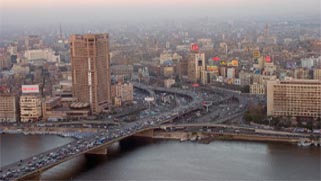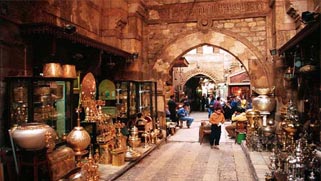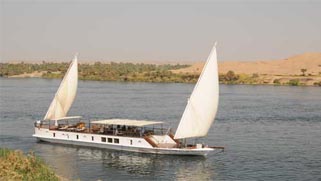|
|

| |
| |
The Temple Island of Philae
The Nubian Museum, one of Egypt’s most modern, opened on
November 16, 1997. Not far from Aswan’s city center (on
the road to the airport), the museum is surrounded by an
extensive park in which numerous monuments and exhibits
are on display. In addition to the many individual
artifacts there is a whole collection of Islamic tombs
and a model of a Nubian house.
The main museum building, of lightly curved design and
dominated by the lavish use of red granite in its
interior decoration, extends over three levels and
provides comprehensive service facilities in addition to
the exhibition rooms themselves.
The artifacts on display have been chosen to reflect the
settlement history of the Nubian region; all periods,
from prehistoric times to the Christian and Islamic era,
are represented with interesting exhibits. Further
interesting information is provided by models and
documentary material (UNESCO projects). |
| |
| |
| |
Temple of Isis -
Ptolemaic period, 3rd – 1st centuries B.C. |
|
| |
The main temple on
Philae was dedicated to Isis and her son Harpocrates
(“Horus the child’). Its ground plan does not correspond
to the traditional schema of a Ptolemaic shrine either
in terms of the configuration of its rooms or its
orientation. Particularly striking is the deviation from
the axis which commences with the second pylon; this is
no doubt explained by the rocky geological conditions
below ground.
Today the large outer courtyard, lined with long
colonnades whose decoration dates from the early Roman
Empire, is entered through a kiosk built by Nectanebo I
(Thirtieth Dynasty). Two granite lion statues and a pair
of obelisks once stood in front of the mighty entrance
pylon (45.5 x 18 m), but these were removed at the
beginning of the 19th century by the Italian adventurer
Giovanni Battista Belzoni.
The reliefs on the first pylon show Ptolemy XII Neos
Dionysos “smiting the enemies.” Above these triumphant
scenes, the ruler is shown in several smaller reliefs
making sacrifices to the gods. On the eastern tower he
can be seen handling the crowns of the kingdom to Horus
and Nephthys and burning incense before Osiris, Isis and
Harpocrates. Set at a diagonal immediately in front of
the eastern tower of the pylon is the large gate of
Ptolemy II Philadelphos, while the central entrance
portal is a Thirtieth Dynasty structure built by
Nectanebo I which was later integrated into the
Ptolemaic temple. The inner courtyard of the temple of
Isis is bordered by the birth house to the left and a
sequence of priests’ rooms to the right. A flight of
steps leads up to the second pylon (32 x 12 m), which
was also decorated during the reign of Neos Dionysos. |
 
|
| |
| |
|
|
|
| |
Incorporated in the
stonework of the tower on the right is a granite outcrop
that has been smoothed down and inscribed with a
dedicatory text from the 24th year of Ptolemy VI
Philometor’s reign.
Behind the pylon lies a small courtyard which can be
covered with an awning as necessary. Behind this is a
vestibule containing eight pillars which once housed a
Christian church (6th century A.D.).
This is revealed by the cross carved into the walls and
a small apse set into the wall.
Various further rooms lead eventually to the inner
sanctum at the end of the temple axis, where the large
pedestal for the cult barque of Isis still stands. The
high-quality bas-reliefs (depicting ritual scenes) were
completed during the time of the temple’s first patron,
Ptolemy II Philadelphos. . |
 
|
| |
| |
Birth House: Row
of columns on the courtyard side |
|
| |
Ptolemaic period,
2nd / 1st centuries B.C. Traditionally, the birth
houses or mammisi of the later shrines are situated
outside the main temple as independent structures.
Philae is the only known example where the mammisi is
incorporated as a peripteral structure into the western
side of the first courtyard. The birth house is entered
through a small door in the western tower of the main
pylon. The central tableau of its inner sanctum, reached
via a vestibule and two further rooms, depicts the
youthful god Horus as a falcon in the marshes of the
Delta where, according to legend, he was brought up
under the protection of his mother. |
 
|
| |
|
| |
 |
The
Philae Temple
The Philae
Temple which was the center of the cult of Isis in
Aswan was mainly constructed by Ptolemy XII and then
many kings from the Greco Roman era contributed by
adding more and more items to the temple |
 |
|
|
|
 |
The Unfinished Obelisk
It is a huge
obelisk dating from the Pharaonic New Kingdom and it
is located in an ancient granite quarry just south
of Aswan. If this gigantic obelisk was completed it
would have weighed 1.8 million kilograms and would
have stood at 41 meters high. |
 |
|
|
 |
The
Nubian Museum
The wonderfully
designed Nubian Museum located to the south of Aswan
is one of the most interesting places to visit in
the city. Nubia, the region located between Aswan
and Khartoum, the Sudanese capital, was inhabited
since prehistoric times. |
 |
|
| |
 |
The
Aswan Museum
The Aswan
Museum is located inside a wonderful garden in the
Elephantine Island. The museum hosts a number of
displays starting from prehistoric times till the
Greco Roman era. A new section was added to the
museum containing the recent finds in Aswan
including a set of jewelry and a marriage contract
dating back to 350 BC |
 |
|
| |
 |
The Agha Khan Mausoleum
Being a land
mark of Aswan, the Agha Khan Mausoleum is located in
a deserted hill on the west bank of the Nile. The
Agha Khan III (1877 -1957) the 48th leader of the
Ismailies sect of Shiites was fond of Aswan where he
used to spend the winter every year |
 |
|
| |
 |
The
Nilometer
Located near
the Aswan Museum, the walls of the Nilometer is
calibrated to record the height of the Nile flood
that used to take place annually in Aswan and the
whole southern region of Egypt. This Nilometer,
which dates back to Pharaonic times, was perused
again after being discovered in 1882 |
 |
|
| |
 |
Abu Simbel
The two rock
temple of Abu simbel are located around 40 KM. north
of the Sudanese border on the west bank of the
modern reservoir (Lake Nasser). Originally hewn into
the cliffs of the Nile riverbank, these two temples
were rediscovered buried in sand by the Swiss
traveler Johann in 1813. Following their successful
rescue, they now stand like skittles in the Nubian
Desert |
 |
|
|
| |
|
 |
 |
 |
 |
 |
 |
 |
Discover Aswan
Due to its warm dry weather and the sun that shines in the city all year long, Aswan is one of the most wonderful winter resorts in Egypt and the whole world. |
Aswan Attractions
Aswan attractions and sightseeing attractions in
Aswan. Book Aswan attraction tours
with Select Egypt |
Aswan Holidays
special discount holiday packages offers for
Aswan travel. We give you tailor made holiday deals for
Aswan travel |
Aswan Tours & Excursions
special discount holiday packages offers for
Aswan excursions. We give you tailor made holiday deals for
Aswan travel |
| Read More >> |
Read More >> |
Read More >> |
Read More >> |
|
| |
 |
| |
 |
 |
 |
 |
 |
Aswan Hotels
Choose from over
50
Luxor hotels with huge savings. Whatever your budget, compare prices and read reviews for all our
Aswan hotels |
Aswan Map
The governorate of Aswan is located at the South of Egypt with the governorate of Qena to the North, and the governorate of the Red Sea with cities like Safaga, |
Aswan Monuments
The best monuments of
Aswan. Information about Aswan monuments, landmarks, historic buildings and museums in
Aswan. |
| Read More >> |
Read More >> |
Read More >> |
|
| |
|
|
|